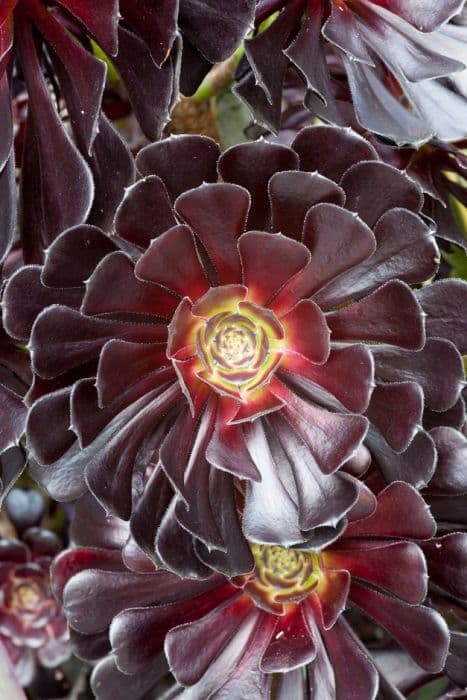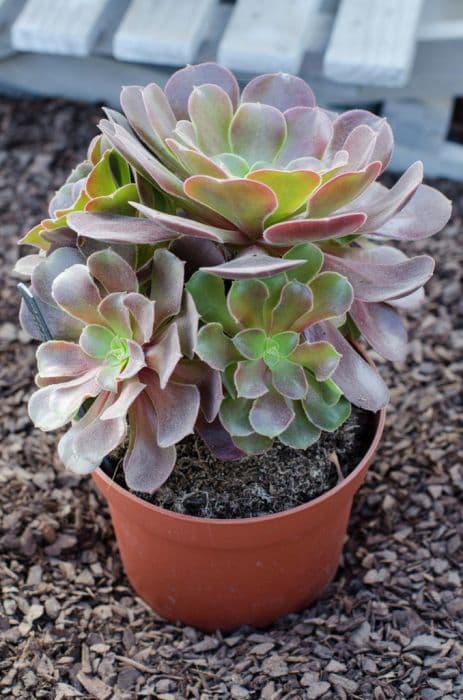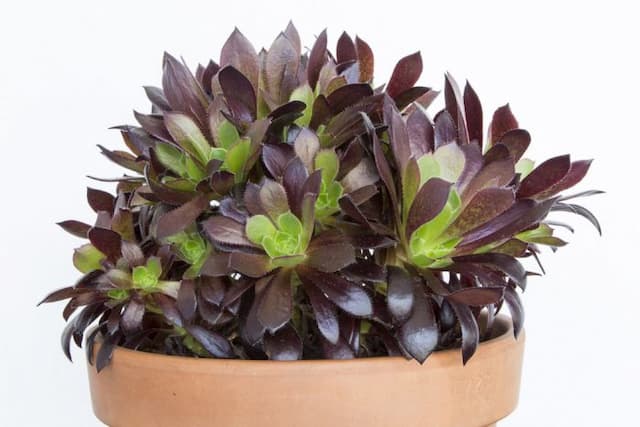Bombycina Echeveria Echeveria × bombycina

ABOUT
Echeveria × bombycina is a succulent plant with a distinctive rosette shape, characterized by a cluster of plump, fleshy leaves that grow outward in a circular pattern. The leaves are often silvery-green in color, with a soft, fuzzy texture that can feel like velvet to the touch. This coating of fine hairs contributes to its silvery sheen, which can be particularly luminous under the bright light. The edges of the leaves stand out as they are often highlighted with a pink or red hue, adding to the ornamental appeal of the plant. From the center of the rosette, flower stalks may emerge, bearing bell-shaped blossoms that contrast with the foliage in color—typically they are a vibrant hue such as red, orange, or yellow. The flowers are arranged in an attractive, loose cluster at the top of each stalk, attracting pollinators when in bloom. This plant has a symmetrical, compact form that is neat and rounded, which makes it a popular choice for rock gardens, container gardens, and as a houseplant. Due to its slow-growing nature, it maintains its shape well and can add a touch of elegance to its surroundings. The aesthetic appeal of Echeveria × bombycina lies in its sculptural quality and the beautiful coloration of its succulent leaves and attractive flowers.
About this plant
 Names
NamesSynonyms
Silky Echeveria, Mexican Hens and Chicks
Common names
Echeveria × bombycina
 Toxicity
ToxicityTo humans
Echeveria is generally considered non-toxic to humans. There are no significant symptoms of poisoning because it is not known to be poisonous upon ingestion.
To pets
Echeveria is generally considered non-toxic to pets. There are no significant symptoms of poisoning because it is not known to be poisonous upon ingestion for animals such as cats and dogs.
 Characteristics
CharacteristicsLife cycle
Perennials
Foliage type
Evergreen
Color of leaves
Varies
Flower color
Pink
Height
0.5 feet (15 cm)
Spread
0.5 feet (15 cm)
Plant type
Succulent
Hardiness zones
9
Native area
Hybrids
Benefits
 General Benefits
General Benefits- Low Maintenance: Echeveria bombycina is easy to care for and doesn't require frequent watering, making it ideal for busy plant owners or those new to gardening.
- Drought-Tolerant: This succulent can thrive with minimal water, making it suitable for dry climates and water-conscious gardeners.
- Aesthetic Appeal: With its rosette shape and attractive leaves, it adds visual interest to any garden, windowsill, or indoor space.
- Versatility: It can be grown both indoors and outdoors, offering flexibility to gardeners with varying amounts of space.
- Propagation: It's easy to propagate from leaves or offsets, allowing for the simple expansion of your plant collection.
- Non-Toxic: Echeveria bombycina is safe to have around pets and children, as it is not known to be toxic.
- Long-Lived: With proper care, these succulents can live for many years, providing long-term enjoyment.
 Medical Properties
Medical PropertiesThis plant is not used for medical purposes.
 Air-purifying Qualities
Air-purifying QualitiesThis plant is not specifically known for air purifying qualities.
 Other Uses
Other Uses- Echeveria × bombycina can be used as a natural art medium for creating living sculptures where the succulents are arranged in a way that over time, they grow and fill out spaces to complete an artistic image.
- The leaves of Echeveria × bombycina, due to their fleshy nature, can be used as improvised "chilling stones" for temporarily keeping small food items cool during a picnic without the mess of melting ice.
- In miniature landscaping such as fairy gardens, the rosettes act as faux trees or bushes, adding to the whimsical aesthetic of the tiny scenes.
- Echeveria × bombycina is sometimes incorporated in jewelry-making, where the small rosettes are featured in glass terrarium pendants or as adornments on eco-friendly rings.
- With its striking rosettes, Echeveria × bombycina can be used for seasonal table centerpieces or place settings that are both aesthetically pleasing and long-lasting.
- During photoshoots, especially for product or fashion photography, these succulents are often employed as organic, textured props to enhance visual interest.
- For educational purposes, Echeveria × bombycina is a good candidate to demonstrate plant propagation techniques like leaf-cutting or offshoot separation in classrooms or workshops.
- Echeveria × bombycina can be grown as part of a green roof installation, particularly in arid regions where its low water requirements make it a sustainable choice for roofing vegetation.
- As a natural dye source, when crushed, the leaves of Echeveria × bombycina may impart subtle colors to fabrics or papers, depending on how they are processed.
- Some artists use the geometric patterns and shapes formed by Echeveria × bombycina rosettes as inspiration or even direct subjects in their drawings, paintings, and digital art.
Interesting Facts
 Feng Shui
Feng ShuiThe Echeveria is not used in Feng Shui practice.
 Zodiac Sign Compitability
Zodiac Sign CompitabilityThe Echeveria is not used in astrology practice.
 Plant Symbolism
Plant Symbolism- Perseverance: Echeverias, due to their succulent nature, are adept at storing water and enduring harsh conditions, symbolizing the ability to persist through challenges.
- Enduring Love: With their long-lasting and evergreen leaves, Echeverias are often seen as a representation of a love that endures over time.
- Timelessness: They don't follow a strict cycle of life and death, which symbolizes a concept of timelessness and enduring presence.
- Beauty and Simplicity: The Echeveria's rosette shape and the simplicity of its form are often associated with an understated elegance and a natural aesthetic.
- Adaptability: As a plant that can thrive in varying conditions, the Echeveria symbolizes adaptability and the ability to thrive in different environments.
 Water
WaterEcheveria bombycina should be watered using the "soak and dry" method, which involves thoroughly soaking the soil and then allowing it to dry out completely before watering again. Typically, during the active growing season in spring and summer, watering once a week using approximately 4-6 ounces of water should suffice. However, in the cooler and dormant winter season, reduce watering to once every two to three weeks. Always check the top inch of the soil for dryness before adding water, as overwatering can lead to root rot.
 Light
LightEcheveria bombycina thrives best in bright, indirect sunlight or partial shade. The ideal spot for this succulent is near a south or east-facing window where it receives plenty of light but is shielded from the intense direct sun of the hot afternoon hours. Too little light can cause the plant to stretch and lose its compact form.
 Temperature
TemperatureThe ideal temperature range for Echeveria bombycina is between 65°F and 80°F. This succulent can tolerate a minimum temperature of around 30°F before being at risk of cold damage. Avoid exposing the plant to temperatures below freezing and provide protection or move it indoors if the temperature drops suddenly.
 Pruning
PruningPruning Echeveria bombycina is generally done to remove dead or damaged leaves and to maintain its appearance. Gently pull away the withered leaves or use a clean pair of scissors or pruners. Pruning is best performed during the growing season in spring to early summer, and it should not be done excessively—only as needed to tidy the plant.
 Cleaning
CleaningAs needed
 Soil
SoilThe best soil mix for Echeveria bombycina, commonly known as "silky echeveria," should be well-draining, such as a cactus or succulent mix with added perlite or pumice. The soil pH should be slightly acidic to neutral, around 6.0 to 7.5.
 Repotting
RepottingSilky echeveria should be repotted every two to three years or when it has outgrown its current pot; this will provide fresh nutrients and prevent the soil from compacting.
 Humidity & Misting
Humidity & MistingSilky echeveria prefers a dry environment with low humidity levels; it thrives in typical indoor humidity conditions which are usually below 40%.
 Suitable locations
Suitable locationsIndoor
Place Silky Echeveria in bright, indirect light with good air flow.
Outdoor
Ensure Silky Echeveria gets morning sun, afternoon shade.
Hardiness zone
9-11 USDA
 Life cycle
Life cycleEcheveria × bombycina, commonly known as Echeveria, begins its life cycle when the seeds germinate, requiring well-draining soil and adequate warmth. Seedlings develop into rosette-forming juveniles, a distinct characteristic of this succulent, which may take several weeks to months. As the plant matures, it forms a tight rosette of plush, silver-green leaves often edged with a hint of pink or red. The Echeveria reaches adulthood and blooms in the warmer seasons, producing bell-shaped flowers on tall stalks, attracting pollinators. Once pollinated, it sets seeds that are then dispersed to begin a new cycle. Throughout its life, the Echeveria can also propagate vegetatively by offsets, where baby plants, or "pups," grow at the base of the parent plant and can be separated to grow independently.
 Propogation
PropogationPropogation time
Spring-Summer
Echeveria bombycina, commonly known as the Silky Echeveria due to its plush leaf texture, can be propagated most effectively through leaf cuttings. This popular method involves gently twisting a healthy leaf from the stem, ensuring the base is intact, and then letting it callous over for a few days in a warm, dry place. Once the end of the leaf has dried, you can place it on top of a well-draining soil mix, avoiding direct sunlight. Water sparingly, only enough to moisten the soil without soaking it, typically using a few tablespoons (approximately 15-30 milliliters) of water. Roots and a new rosette will eventually form at the base of the leaf, which may take several weeks. Once the new plant has established a sufficient root system, it can be transplanted into its own pot. This method is preferred due to its simplicity and the ability to produce multiple plants from a single leaf.









